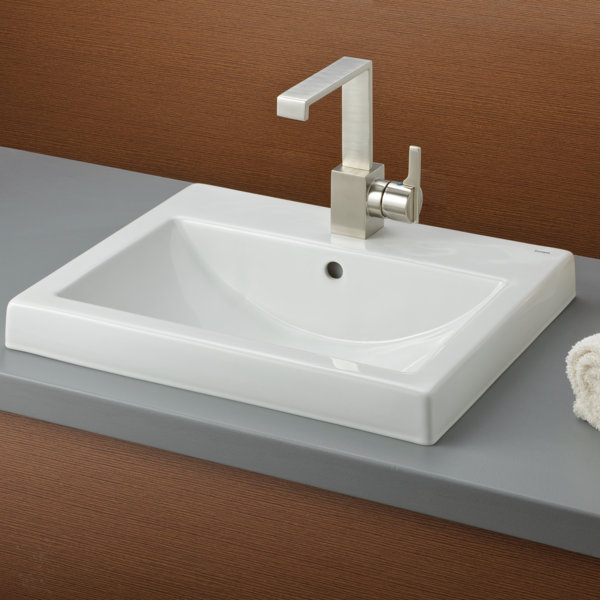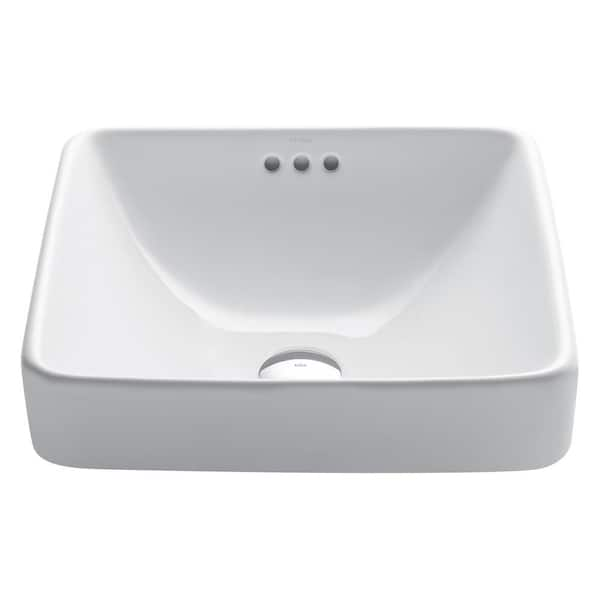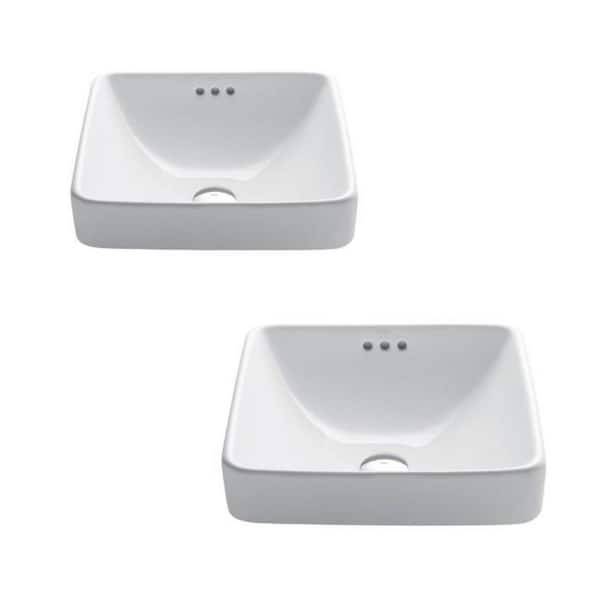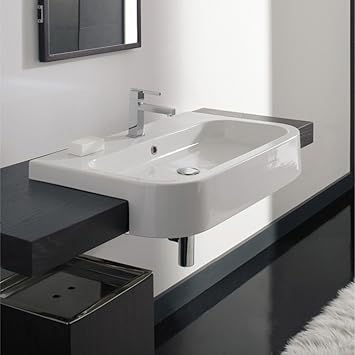What is a Recessed Bathroom Sink? An Overview
If you’re renovating your bathroom or just looking to upgrade your sink, you might have come across the term “recessed bathroom sink.” But what exactly does that mean? Simply put, a recessed sink is a type of sink that sits below the countertop surface, creating a smooth, streamlined look. Let’s discover what makes recessed sinks unique and why they’re popular in modern bathrooms.
- A Sleek and Seamless Design: Recessed sinks are known for their sleek, modern appearance. Because the sink is mounted below the countertop, no visible edge or lip is sticking up. This creates a seamless look perfect for minimalist or contemporary bathroom designs. It’s a style that says “clean” and “understated” without sacrificing functionality.
- Easy to Clean and Maintain: One of the biggest perks of a recessed sink is how easy it is to keep clean. Since there are no edges where dirt and grime can collect, it’s super simple to wipe down the countertop right into the sink. This design eliminates those awkward spots that are tough to clean with other sink styles.
- A Range of Shapes and Sizes: Recessed sinks come in various shapes and sizes, making them versatile enough to fit almost any bathroom. Whether you prefer a rounded, rectangular, or even asymmetrical design, there’s a recessed sink that can complement your space. This flexibility makes it easier to match your sink with other bathroom elements.
- Works with Various Countertop Materials: Recessed sinks work well with almost any countertop material, including granite, quartz, marble, and solid surface options. The under-mounted design shows off more of your countertop, which can be a great way to highlight beautiful materials and patterns.
- Suitable for Modern and Traditional Bathrooms: While recessed sinks are often associated with modern design, they can work beautifully in traditional settings too. It all depends on the sink’s shape, material, and the countertop you pair it with. A classic white porcelain sink can look just as at home in a vintage bathroom as in a sleek, modern space.
- A Staple in High-End Bathrooms: Recessed sinks are a staple in luxury and high-end bathroom designs because of their streamlined, sophisticated look. If you’re aiming to create a bathroom that feels a bit more upscale, installing a recessed sink can be a relatively easy way to elevate the space.

Pros and Cons of Recessed Bathroom Sinks: Is It Right for You?
Recessed sinks are undoubtedly stylish, but like any bathroom fixture, they come with their own set of advantages and disadvantages. If you’re considering this type of sink for your bathroom, it’s important to weigh the pros and cons to see if it’s the right fit for you. Here’s a closer look at what you can expect.
Pro: Easy to Clean and Maintain
One of the biggest benefits of recessed sinks is how easy they are to clean. Since the sink is mounted under the countertop, there are no lips or edges where dirt can accumulate. This design allows for a quick wipe-down, keeping both the sink and countertop looking pristine.
Pro: A Modern, Streamlined Look
Recessed sinks are all about clean lines and simplicity, making them a perfect choice for modern and minimalist bathroom designs. The lack of visible edges creates a seamless look that adds a touch of elegance to any bathroom, big or small.
Pro: More Countertop Space
Since the sink is below the counter, you get a bit more usable space on top. This can be a game-changer in smaller bathrooms where every inch of counter space matters. It also gives you more room to place your toiletries without them being in the way of the sink.
Con: More Complex Installation
On the downside, recessed sinks are trickier to install than drop-in sinks. They require precise measurements and a solid surface countertop, which can make DIY installation a bit of a challenge. You’ll likely need a professional to ensure it’s done right.
Con: Limited to Solid Surface Countertops
Recessed sinks can’t be installed on just any countertop material. They work best with solid surfaces like stone, quartz, or solid surface materials that can support the sink’s weight and create a water-tight seal. Laminate or tile countertops typically aren’t suitable for recessed sinks.
Con: Higher Cost
Because of the need for professional installation and the compatibility with higher-end countertop materials, recessed sinks can be more expensive overall. If you’re on a tight budget, this is something to consider before making your decision.
Design Styles and Materials for Recessed Bathroom Sinks
Choosing the right recessed sink isn’t just about function—it’s also about style. The good news is, that there’s a wide range of design styles and materials available, so you can find the perfect sink to complement your bathroom decor. Let’s explore some popular options to inspire your next bathroom upgrade.
Classic Porcelain Recessed Sinks
Porcelain is a timeless choice for bathroom sinks, and it’s easy to see why. It’s durable, easy to clean, and has a classic look that works in both modern and traditional bathrooms. A porcelain recessed sink can add a touch of elegance without overpowering the rest of your design.
Sleek Stainless Steel Sinks
Stainless steel isn’t just for kitchens—it can look fantastic in a bathroom too. Recessed stainless steel sinks offer a sleek, industrial vibe that pairs well with modern or contemporary designs. Plus, they’re incredibly durable and resistant to stains and scratches.
Elegant Glass Sinks
If you’re looking to make a statement, consider a glass recessed sink. These sinks come in a variety of colors and finishes, from clear and frosted to vibrant shades. They add a touch of luxury and can become a stunning focal point in your bathroom.
Natural Stone Recessed Sinks
Stone sinks, like granite or marble, bring a natural, organic element to your bathroom. They’re perfect for rustic or spa-inspired designs, and each sink has its own unique pattern and color variations, adding a one-of-a-kind touch to your space.
Modern Concrete Sinks
Concrete is a growing trend in bathroom design, and recessed concrete sinks can add an edgy, industrial look. They’re highly customizable, allowing you to play with different colors, textures, and shapes. Plus, concrete is incredibly durable when properly sealed.
Solid Surface Recessed Sinks
Solid surface materials, like Corian, offer a sleek, seamless look that’s perfect for modern bathrooms. These sinks are available in a wide range of colors and finishes, and they can be integrated directly into the countertop for a completely smooth, cohesive appearance.
How to Choose the Perfect Recessed Sink for Your Bathroom
Selecting the right recessed sink for your bathroom can be overwhelming with all the options out there. But don’t worry—I’ve got you covered! Here’s a step-by-step guide to help you choose the perfect recessed sink that matches your style, budget, and practical needs.
Consider Your Bathroom Style
Start by thinking about the overall style of your bathroom. Is it modern, traditional, rustic, or eclectic? Your sink should complement the existing decor. For example, a sleek glass sink might look out of place in a rustic bathroom, but it would be perfect in a contemporary setting.
Measure Your Space
Size matters when it comes to choosing a sink. Measure your available counter space and ensure that the sink you select fits comfortably without overwhelming the area. Keep in mind the size of the faucet and any additional countertop space you’ll need for toiletries.
Pick the Right Material
The material of your sink can impact not just the look but also the durability and maintenance. Porcelain is easy to clean, while natural stone can be more high-maintenance. Consider how much time you’re willing to spend on upkeep when choosing the material.
Think About Functionality
A sink that looks great is important, but it also needs to work well for your daily needs. If you have a busy household, consider a sink that’s easy to clean and resistant to stains. If you’re aiming for a spa-like feel, something like a natural stone or glass sink can add to the ambiance.
Match Your Faucet
Don’t forget to choose a faucet that complements your sink. The faucet style, finish, and placement can dramatically affect the overall look of your bathroom. Make sure the faucet’s reach and height work well with the depth and size of your recessed sink.
Set Your Budget
Recessed sinks come in a wide range of prices, from budget-friendly options to high-end designs. Decide how much you’re willing to spend and stick to your budget. Remember to factor in the cost of installation if you’re not planning to DIY.
Installation Guide for Recessed Bathroom Sinks: DIY vs. Professional Help
Thinking about installing a recessed sink in your bathroom? While it’s possible to tackle this project yourself, there are some key things to consider before getting started. Here’s a guide on how to install a recessed bathroom sink and when it might be best to call in the pros.
Gather Your Tools and Materials
If you’re going the DIY route, make sure you have all the necessary tools on hand. You’ll need a jigsaw or hole saw for cutting the countertop, silicone sealant, mounting clips, and plumbing tools. Double-check your sink’s instructions for any specific requirements.
Measure and Mark the Cutout
Start by measuring the sink and marking the cutout area on the countertop. It’s crucial to get these measurements right—too big, and your sink won’t sit properly; too small, and it won’t fit at all. Use a template if your sink comes with one, or make your own from cardboard.
Cut the Countertop
Carefully cut along your marked lines using a jigsaw or hole saw. Make sure to follow safety precautions, like wearing goggles and a dust mask. Cutting through stone or solid surface countertops can be challenging, so take your time to ensure a clean, precise cut.
Install the Sink and Seal
Place the sink into the cutout and check for a good fit. Apply a bead of silicone sealant around the edge of the sink to create a watertight seal. Use mounting clips or brackets to secure the sink to the underside of the countertop, following the manufacturer’s instructions.
Connect the Plumbing
Attach the drain and faucet to your sink, making sure all connections are tight and leak-free. This step can be tricky if you’re not familiar with plumbing, so take your time and double-check everything. If leaks persist, it might be time to call in a professional plumber.
When to Hire a Professional
While installing a recessed sink is doable for a seasoned DIYer, there are times when it’s best left to the pros. If your countertop material is difficult to cut, or if you’re uncomfortable with plumbing, hiring a professional can save you time, frustration, and potential costly mistakes.
Maintenance Tips for Keeping Your Recessed Bathroom Sink in Top Condition
A recessed bathroom sink is an investment, and like any investment, you’ll want to keep it looking its best. Fortunately, maintaining your sink doesn’t have to be a chore. Here are some easy maintenance tips to ensure your recessed sink stays in top-notch condition for years to come.
Regular Cleaning is Key
The first step in keeping your sink in great shape is regular cleaning. Use a gentle, non-abrasive cleaner and a soft cloth or sponge to wipe down the sink after each use. This helps prevent soap scum, hard water stains, and other buildup from taking hold.
Avoid Harsh Chemicals
Harsh cleaners, especially those containing bleach or ammonia, can damage certain sink materials like stone or glass. Stick to mild cleaners and avoid anything too abrasive that could scratch or dull the surface of your sink.
Seal Stone Sinks Regularly
If you have a natural stone recessed sink, sealing it regularly is crucial to prevent stains and damage. Stone is porous, which means it can absorb liquids and become stained over time. A good sealant will protect the stone and keep it looking fresh.
Check for Leaks and Tighten Connections
Periodically check the plumbing connections under your sink to ensure there are no leaks. Loose connections can lead to water damage and mold growth, so it’s best to address any issues as soon as you spot them.
Protect the Surface from Scratches
While most sink materials are durable, they can still scratch if you’re not careful. Avoid placing sharp objects directly in the sink, and use a sink mat or grid if necessary. This extra layer of protection can help keep your sink looking flawless.
Tackle Stains Promptly
If you notice any stains starting to form, address them right away. For stubborn stains, make a paste of baking soda and water, apply it to the stain, and let it sit for a few minutes before scrubbing gently. Always rinse thoroughly afterward to avoid residue buildup.
Common Mistakes to Avoid When Installing a Recessed Bathroom Sink
Installing a recessed bathroom sink can seem straightforward, but some common pitfalls can lead to frustrating issues down the line. To help you avoid these mistakes, here are some of the most frequent errors and how to steer clear of them.
Incorrect Measurements
One of the most common mistakes is getting the measurements wrong. If the cutout in your countertop isn’t the right size, your sink won’t fit properly, leading to gaps, leaks, or the need for costly re-cuts. Always double-check your measurements before making any cuts.
Not Using the Correct Sealant
Using the wrong type of sealant can cause your sink to become loose or allow water to seep through, leading to water damage. Make sure to use a high-quality silicone sealant that’s designed for bathroom use, and apply it generously around the edges of the sink.
Skipping the Mounting Clips
Mounting clips are there for a reason—they secure your sink to the countertop and prevent it from shifting or sagging over time. Skipping these clips or using the wrong type can compromise the stability of your sink, so always follow the manufacturer’s instructions.
Improper Drain Installation
A poorly installed drain can lead to leaks and unpleasant odors. Take your time when connecting the drain components, ensuring each part is tightly sealed and properly aligned. If you’re not confident in your plumbing skills, don’t hesitate to call a professional for this step.
Choosing the Wrong Faucet
Your faucet needs to be compatible with the size and style of your sink. A faucet that’s too short or too tall can make using the sink awkward or create splashing issues. Measure carefully and select a faucet that complements both the sink and your bathroom’s overall design.
Ignoring the Countertop’s Weight Capacity
Not all countertops can handle the weight of certain recessed sinks, especially those made of heavy materials like stone. Before installing, make sure your countertop can support the sink’s weight without bowing or cracking. Reinforcements may be necessary for particularly heavy sinks.
Next Semi Recessed Single Hole Bathroom Sink – Vessel Sinks
Related Posts:
- Bathroom Sink Faucets With Porcelain Handles
- Bathroom Sink Stopper Broken
- Kohler Ladena Undermount Bathroom Sink
- Recessed Bathroom Sink
- Roca Bathroom Sink
- How To Remove Yellow Stains From Bathroom Sink
- Handicap Accessible Bathroom Sink
- Tempered Glass Bathroom Sink
- How To Use A Snake To Unclog A Bathroom Sink
- Red Glass Bathroom Sinks






